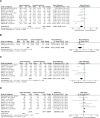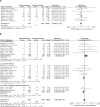General versus spinal anesthesia in percutaneous nephrolithotomy: A systematic review and meta-analysis
- PMID: 38618023
- PMCID: PMC11016174
- DOI: 10.12688/f1000research.124704.2
General versus spinal anesthesia in percutaneous nephrolithotomy: A systematic review and meta-analysis
Abstract
Background: Percutaneous nephrolithotomy (PCNL) is the preferred treatment for the removal of large kidney stones, sized >20 mm. However, there is still an ongoing debate concerning the best anesthesia for PCNL. This study aimed to compare the efficacy and safety between general and spinal anesthesia for PCNL. Methods: A systematic review and meta-analysis study. A systematic, electronic literature search was performed in several databases, including PubMed, Scopus, and Google Scholar until July 1 st, 2022. The quality of the articles was examined using Crombie's Items (for non-randomized controlled trials (RCTs)) and Jadad Scale (for RCTs). The outcomes assessed were operation time, fluoroscopy time, length of stay, stone-free rate, overall complication rate, specific postoperative complications, cost, pain score, and postoperative analgesic requirement. The article selection was reported based on the Preferred Reporting Items for Systematic Reviews and Meta-Analysis (PRISMA) guidelines. We assessed four RCTs and eight retrospective studies. Meta-analysis of selected studies was performed using the Review Manager 5.3. Results: General anesthesia resulted in fewer Clavien-Dindo grade II (OR: 0.68; 95% CI: 0.49 - 0.94; p=0.02), major complications (OR: 0.65; 95% CI: 0.45 - 0.94; p=0.02, and lower transfusion rates (OR: 0.70; 95% CI: 0.53 - 0.94; p=0.02). Whereas spinal anesthesia resulted in faster operation time (Mean Difference: -12.98; 95% CI: -20.56 - -5.41; p<0.001, fluoroscopy time (MD: -26.15; 95% CI: -42.79 - -9.50; p=0.002), reduced length of stay (MD: -0.47; 95% CI: -0.75 - 0.20; p<0.001), and lower postoperative analgesic requirement and cost. No significant difference in stone-free rate (OR: 1.08; 95% CI: 0.92 - 1.26; p=0.37). PCNL performed using either general anesthesia or spinal anesthesia is equally safe and effective. Conclusions: Each method of anesthesia has its own advantages and disadvantages. The final choice between general and spinal anesthesia should be based on the patient's condition and surgical team preference.
Keywords: Complication; General Anesthesia; PCNL; Spinal Anesthesia; Stone-free Rate.
Copyright: © 2023 Indra Rachman R et al.
Conflict of interest statement
No competing interests were disclosed.
Figures




References
-
- Türk C, Neisius A, Petrik A, et al. : EAU Guidelines on Urolithiasis. Eur. Assoc. Urol. 2018;2018:1–87. Reference Source
-
- Nelson CP, Pace KT, Jr, Pearle MS, et al. : Surgical Management of stones. Am. Urol. Assoc. 2016; (April):1–50.
-
- Gonen M, Basaran B: Tubeless percutaneous nephrolithotomy: Spinal versus general anesthesia. Urol. J. 2014;11(1):1211–1215. - PubMed
Publication types
MeSH terms
LinkOut - more resources
Full Text Sources
Medical

